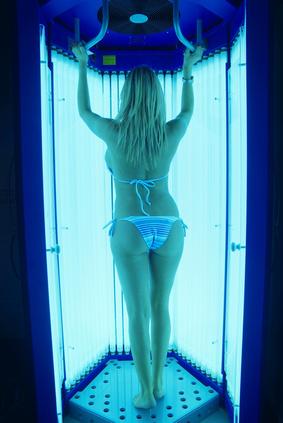Sunscreen use is necessary to protect your skin from sunburn, signs of photoaging and various types of skin cancer, says the American Academy of Dermatology. A broad-spectrum sunscreen with a sunscreen protection factor of 30 or more is advised anytime you go outdoors. However, knowing if your sunscreen gives you equal protection in a tanning bed means first understanding what–if anything–makes tanning beds any different from direct exposure to the sun.
Tanning Beds and UV Rays
Two types of skin-damaging rays are emitted by the sun: ultraviolet A rays, those that give you a tan, and ultraviolet B rays, those that cause your skin to burn, explains the AAD. Indoor tanning beds emit both UVA and UVB radiation, just like the sun. According to the AAD, sometimes the radiation produced by a tanning bed is even stronger. Yet more than one million Americans visit a tanning salon on any given day, 70 percent of whom are females between the ages of 16 and 29.
About Sunscreens
A sunscreen that gives you broad-spectrum protection shields you from both UVA and UVB rays. The AAD states that sunscreen ingredients offering broad-spectrum protection include avobenzone, cinoxate, ecamsule, menthyl anthranilate, oxybenzone, octyl salicylate, octyl methoxycinnamate, titanium dioxide, zinc oxide and sulisobenzone. Some sunscreens filter out only UVB rays that cause sunburn but allow your skin to soak in UVA rays–and give you a tan.
About Sun Protection Factor
When you look at a sunscreen’s sun protection factor, or SPF, it’s important to know that this rating system is designed to give you some idea as to how well your skin is protected from UVB rays, says skincare expert Paula Begoun. She states that the U.S. Food and Drug Administration has adopted no UVA rating system. If premature wrinkles and sun-weathered skin are what you hope to prevent, UVA rays are your prime enemy.
Understanding SPF
Your product’s SPF number is a relative factor; for example, a sunscreen with a SPF of 30 won’t let you stay in a tanning bed twice as long as one with a SPF of 15 without assurance of burning. The AAD points out that a sunscreen with an SPF of 15 filters out 93 percent of UVB rays, while one with a SPF of 30 filters out 97. Yet other factors come into play, such as your skin tone and if the sunscreen is applied liberally to cover all areas of exposed skin.
What the Experts Say
If you apply a broad-spectrum sunscreen with a SPF that gives you adequate protection against burning UVB rays, it may offer you similar or even less protection in a tanning bed as it does under the glare of the sun–at least theoretically. However, the AAD adamantly stresses the importance of avoiding indoor tanning, stating that there’s no such thing as a “safe” way to tan. UV rays are damaging to your skin, no matter how you’re exposed to them. Many tanning salons allow fair-skinned people access to beds with little regard to skin safety, cautions the AAD.
Photo Credit
- sexy tanning image by Alfonso d’Agostino from Fotolia.com





